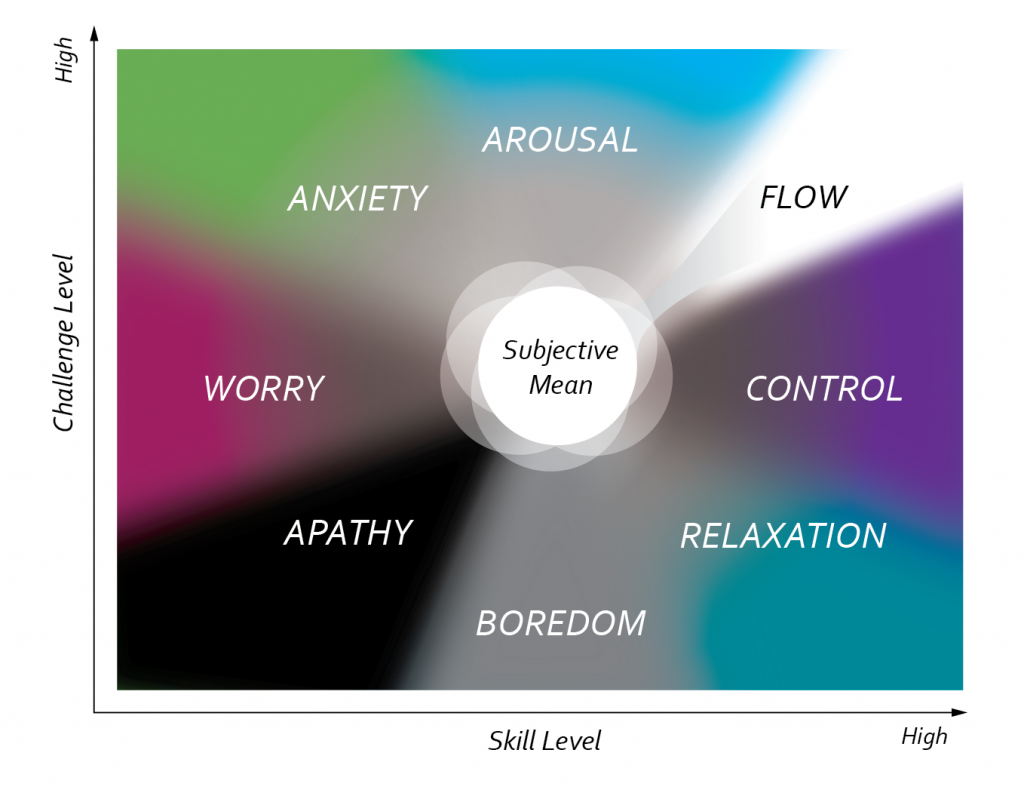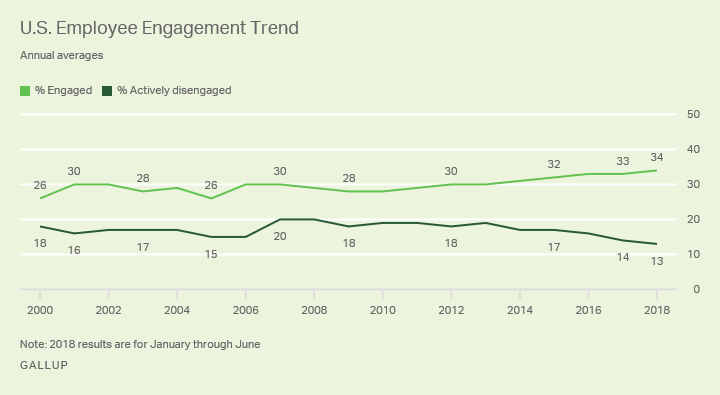Flow Map as a Management Tool – Part 1
The Missing Engagement
The purpose of this article is to introduce the “Flow map,” or the “map of everyday experience,” as Mihaly Csikszentmihalyi calls it in his book “Good Business: Leadership, Flow, and the Making of Meaning” (2004).
The Flow map is the core feedback system of our business simulation game FLIGBY. The Game is designed to teach Flow-promoting leadership skills where managers learn to understand and track their teams’ mental states and experience first-hand how their decisions affect productivity and business results. As a practical management tool, the Flow map allows leaders to assess the condition of employee experience to intervene when necessary.
Consider this statistic: although positive business outcomes are strongly related to employee engagement, only 34% of all employees report being actively engaged at work (Gallup, 2018). According to the same research, 70% of team engagement is attributed to leadership quality. Not only productivity but also job satisfaction is closely related to the employees’ levels of engagement in their work.
Employee Engagement on the Rise in the U.S. (Gallup, 2018):
The most reliable ways of predicting if employees are engaged are to assess how often they enter the mental state of Flow, the ultimate form of engagement characterized by complete absorption, deep focus, and optimal performance. Managers increasingly turn to Flow-promoting approaches to leadership to intervene in employee engagement and boost productivity. They often find that the best place to start is to map out the current state of their teams’ engagement so they can make a well-informed decision on enhancing performance.
Why Flow is important
Flow is a mental state of authentic engagement that leads to optimal performance. The awareness of its existence within a group or an organization can be very useful in understanding individual and collective motivation. The greater the Flow in an organization – that is, the greater the number of key employees who frequently experience Flow – the better the unit’s performance.
Flow is an individual state of mind, but Flow-promoting leadership strategies enable more significant numbers of employees to experience it on the job. People managers trained in recognizing conditions that promote Flow-through business simulation games like FLIGBY are better equipped to help their people create personal strategies to reach Flow. Those who can map out their team’s motivational states on the Flow map can intervene in their work environments’ team dynamics and conditions to foster greater engagement.
The most distinguishing trait of visionary leaders is that they believe in a goal that benefits themselves and others. It is such a vision that attracts the psychic energy of other people and makes them willing to work beyond the call of duty for the organization.” – Csikszentmihalyi (2004)
Flow-promoting leadership benefits better performance and bottom line and promotes job satisfaction that echoes across those engaged in meaningful and fulfilling work. Enterprises where employees experience flow and develop toward greater complexity and where an organization’s product or service contributes to positive human growth are examples of good business per Csikszentmihalyi. In these unique organizations, employees can do what they do best, leading to higher productivity, lower turnover, more significant profit, customer satisfaction, and workplace safety. The level of engagement, involvement, or degree to which employees are positively stretched also contributes to the well-being experience at work.
The primary goal of Flow-promoting leadership is to help everyone find the best personal strategy to steer them toward the Flow state. To promote Flow, leaders must recognize when the opportunities to act are different from individual capabilities so they can adjust the level of challenge at work or look for ways to strengthen the skills needed. When employees are not challenged enough, they can experience relaxation and boredom, which can get in the form of motivation to do their best. When their skills are insufficient to meet the opportunities to act, they can become anxious and worried, impairing their focus and performance.
Decades of research exploring the Flow theory show that when challenges at hand are matched to personal skills, and both are high, the potential for happy, focused energy leads to the experience of total absorption and optimal performance.
“Attention is psychic energy, and like physical energy unless we allocate some part of it to the task at hand, no work gets done.” – Csikszentmihalyi (2004)
Although Flow is an individual state of mind, it has reportedly been experienced to an even greater level in cohesive teams where healthy competition drives personal strivings toward excellence, giving all the more reason to cultivate Flow on the team level (Roberts, 2004).
To steer employees toward greater engagement, a good leader should be aware of their current motivational state and be able to recognize all the other states and what is happening when their employees are not in Flow. In other words, influential leaders must have a degree of social and emotional intelligence. Games like FLIGBY simulate scenarios where crucial soft skills are progressively developed and where the Flow map becomes an ideal tool for identifying everyone’s emotional states for visualizing team dynamics.
Managing Flow: Map of Everyday Experience
Map of Everyday Experience by Csikszentmihalyi (The “Flow map”):

Flow is experienced on the individual level and is distinguished from other mental states in how the story of the challenge is mismatched to the perception of one’s skills and resources. Some of the key indicators of this paradox are expressed through one’s mood, self-esteem, and levels of focus and concentration, and how those, in turn, affect behavior and on-the-job performance.
Mood, self-esteem, concentration, level of challenge, and availability of skills all play an essential role in cultivating engagement, but only a leader can effectively intervene in the last two. The good news is that developing skills brings on greater self-esteem and positive feelings, and increasing challenges narrows the focus, leading to better concentration. When put together, these conditions promote Flow and greater engagement in the task at hand and can lead to the experience of Flow at work.
“However, a good life consists of more than simply the totality of enjoyable experiences. It must also have a meaningful pattern, a trajectory of growth that results in the development of increasing emotional, cognitive, and social complexity.” – Csikszentmihalyi (2004)
Our leadership simulation game FLIGBY teaches managers to recognize eight different states of mind employees may be experiencing, with Flow being the ideal state. While flexing their emotional intelligence muscles, players can test different risk-free strategies for moving everyone toward Flow and optimal functioning.
The eight states of flow, arousal, control, relaxation, boredom, anxiety, worry, and apathy are described below with corresponding characteristics and behaviors.
Flow – When employees are in the state of Flow, they are happy and intensely focused. Their skills are high and so well matched to high challenges that their activity seems effortless, as if their being was merged with what they are doing. Their self-consciousness disappears, and their sense of time becomes distorted as they are being taken away by whatever they are doing.
Activities with specific properties create the state of Flow: they are challenging, require skill, and have clear and immediate feedback. The key to success here is setting challenges that are neither too demanding nor too simple for one’s abilities. Csikszentmihalyi identified specific conditions that allowed for the onset of Flow and named the factors related to Flow experiences into nine dimensions:
- High challenges matched with adequate personal skills; most often achieved in complex activities requiring specific capabilities; flow proved to be associated with the above-average challenge/above-average skill condition;
- Merging of action and awareness; the task has to be challenging enough to require the mobilization of personal skills, promoting concentration and engagement as repetitive and low-information activities are very rarely associated with the Flow;
- Clear goals;
- Immediate feedback;
- Concentration on the task at hand and focused attention;
- Perceived control of the situation, which comprises a cognitive and stable core;
- Loss of self-consciousness;
- Altered sense of time;
- And intrinsic motivation and autonomous initiative.
Arousal – Closely related to Flow is the mental state of arousal. The challenges are slightly higher than ideal, so employees do not feel quite at ease and must concentrate. The prevailing attitudes in the state of arousal are being focused, energetic, and self-motivated to learn, grow, and take action. But people also tend to feel restless and are prone to risk-taking, so supportive and affirming managers can help them find balance and perspective.
Control – Another positive state from within which Flow is easily accessible is control. Usually experienced when skills are high but slightly outweigh challenges and the activity no longer requires deep concentration. Employees with a sense of control over their tasks are confident, productive, enthusiastic, and enjoy their jobs but need to be stretched enough to experience Flow and tend to do things the same way. To reach Flow, the level of challenge may need to be increased to narrow the focus to the task at hand.
Arousal and control are positive states that lead to learning and have similar benefits to Flow, but most importantly, they signal that Flow is within reach. The model below pictures these states in terms of matching skills to challenges and defines Flow as an intersection of high skills and challenges.
Relaxation – When skills are high but significantly outweigh opportunities to act, efforts can be relaxed. Employees are calm, confident, and content but must be challenged to their fullest potential. This state is associated with maintenance and routine actions. It can lead to boredom over time as it provides a different level of enjoyment or involvement than the state of Flow. To prevent eventual disengagement, increasing the level of challenge or even introducing new opportunities may be appropriate.
Boredom – When a lack of challenges continually fails to engage personal capacities, over time, the sense of contentment gives way to negative feelings and can lead to depression. Routine and repetitive tasks that do not allow employees to use their skills fully and require little concentration often make them feel like they lived on autopilot. Bored employees are often mentally checked out and tend to complain, procrastinate, and avoid conflict. The best way to address the mismatch of medium skills and lack of opportunities to act is to increase the level of challenge just beyond the current level of capabilities.
Anxiety – On the other hand, anxiety is created by perceiving a significant gap between one’s skills and challenges. When work demands feel unsurmountable and exceed one’s capabilities, stress affects performance and brings negative emotions. Depending on personality, employees respond differently to excessive pressure; some are aggressive, while others practice avoidance. The best approach is first to allow the person to find balance and potential solutions themselves and offer support when only when needed so as not to create further resistance.
Worry – Over time, stress leads to burnout and can result in worry and a paralyzing perspective that the situation is beyond one’s control. When skills are low and don’t meet reasonable challenges, fear sets in, and employees become reactive, risk-avoidant, critical, and increasingly pessimistic. Worried employees need support, and it is best to discuss their concerns, identify gaps in knowledge, teach new methods, extend deadlines, and introduce positive reinforcements.
Apathy – Worry and boredom can lead to apathy, where low skill and low challenges make people feel sad and listless because they lead them nowhere. Apathy, anxiety, and boredom are strong predictors of what gets in the way of motivation. They may require a multi-step strategy to raise one’s skills or challenges before they can experience Flow.






